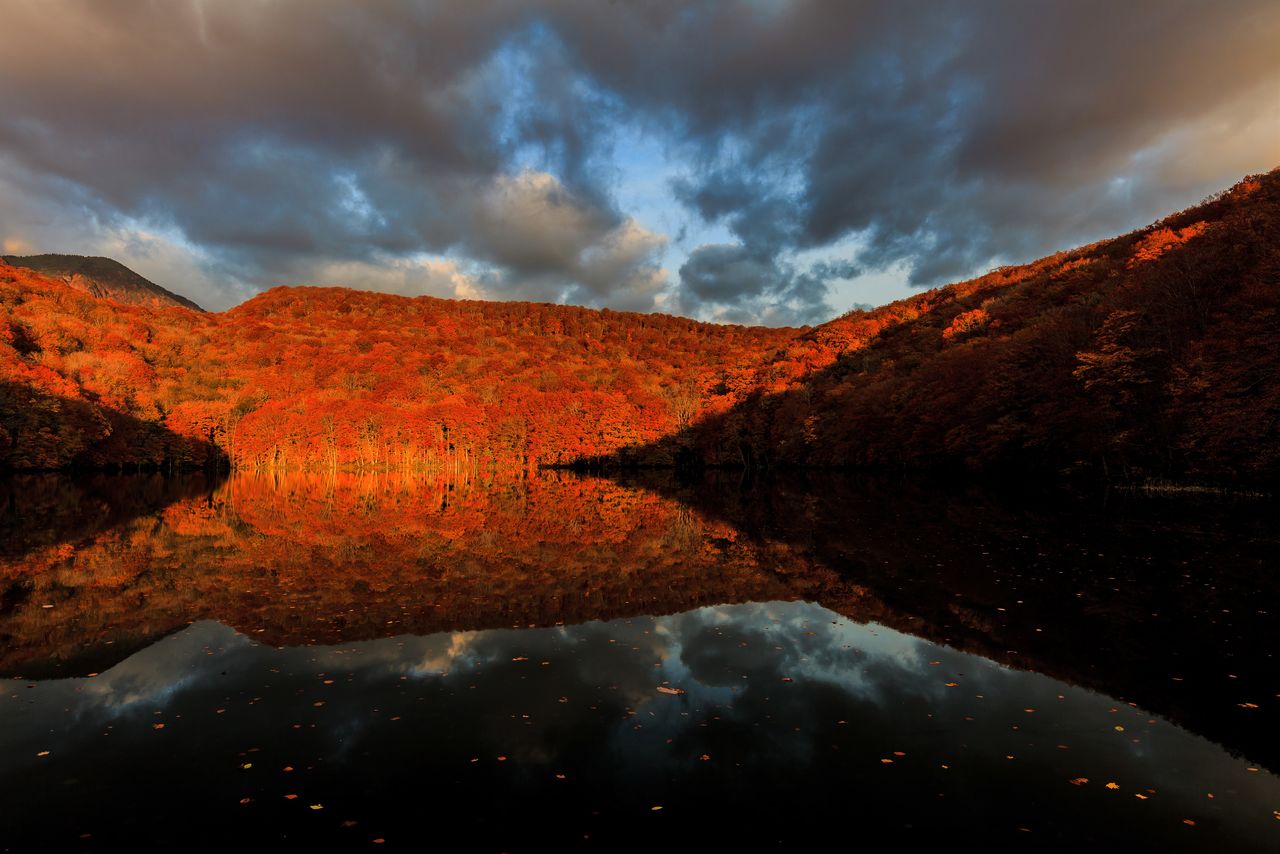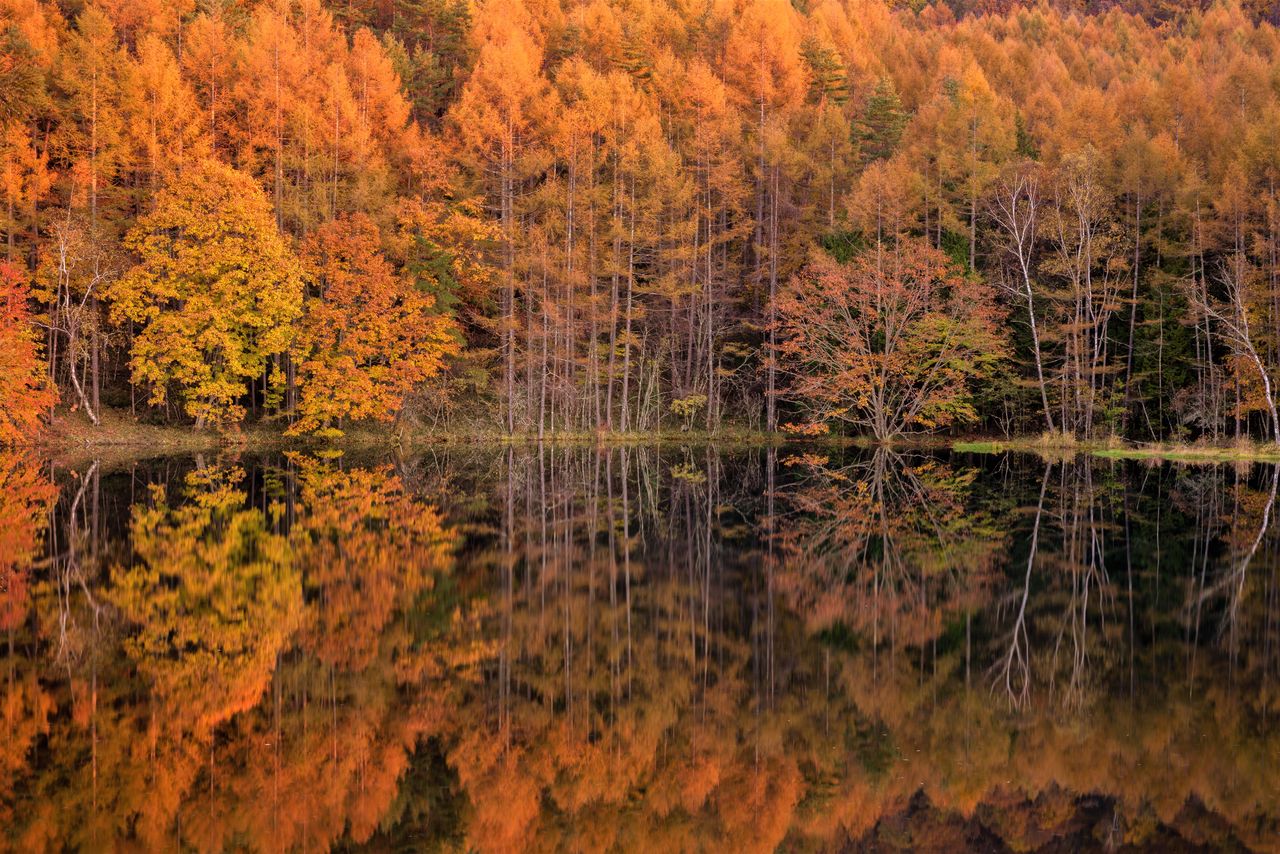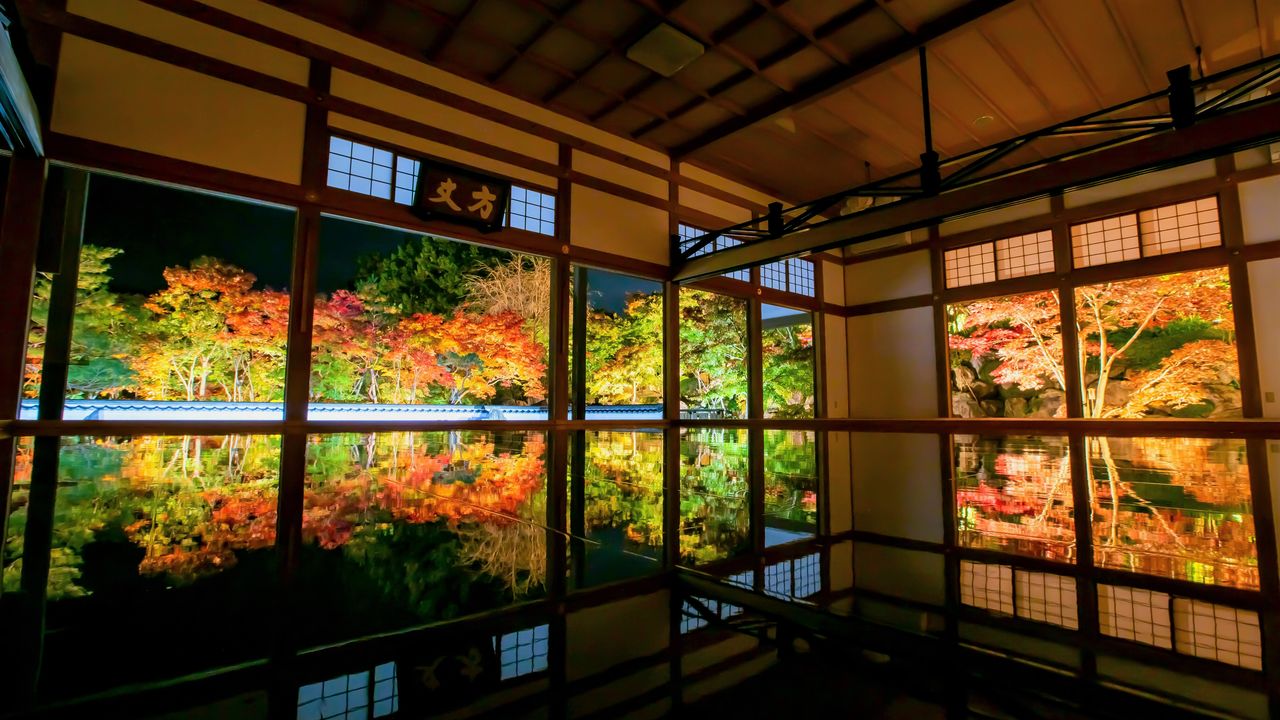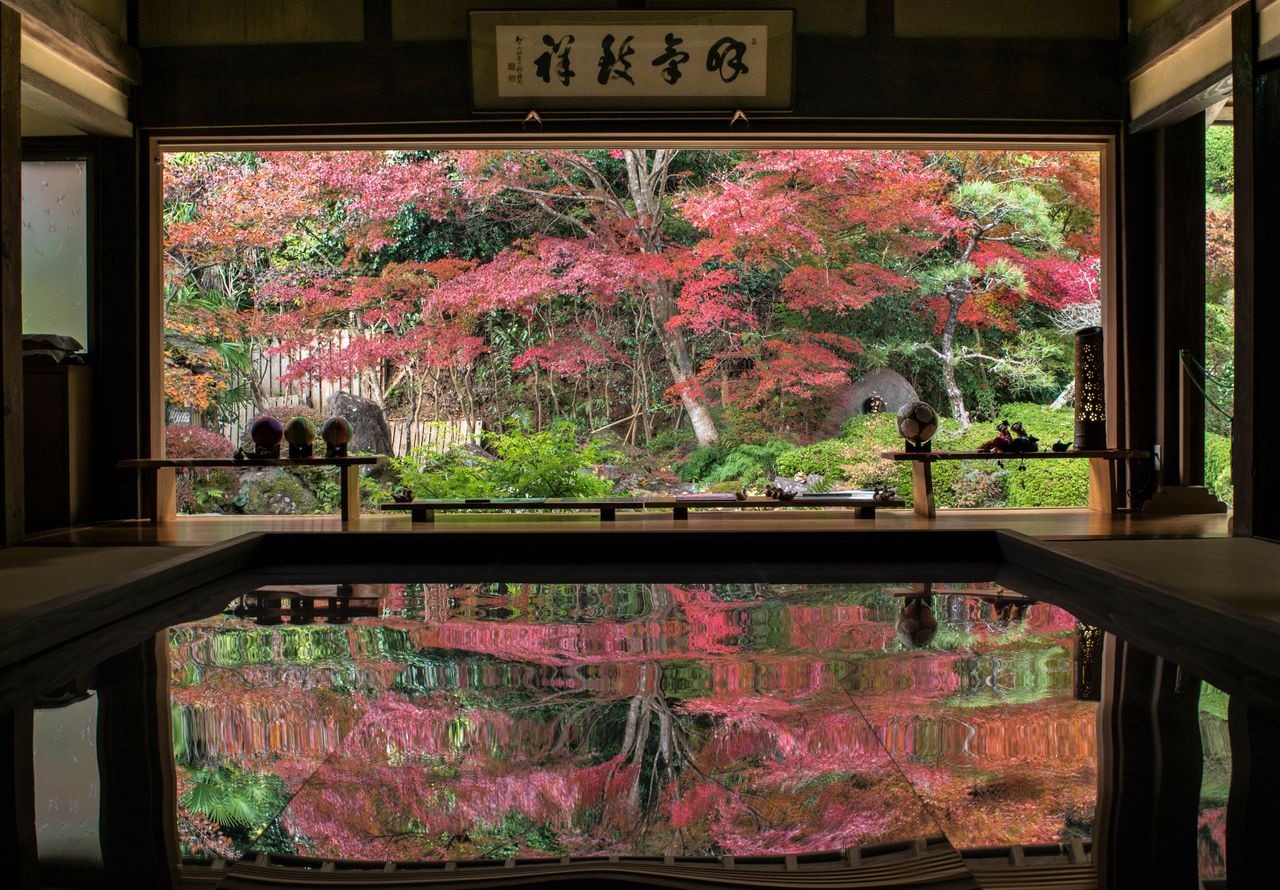Seasonal Magic: Upside-Down Reflections Produce Spellbinding Autumn Scenes
Newsfrom Japan
Travel Art Environment- English
- 日本語
- 简体字
- 繁體字
- Français
- Español
- العربية
- Русский
Tsutanuma: A Fleeting Miracle of Color (Towada, Aomori Prefecture)
Autumn brings enchanting views such as “upside-down foliage,” akin to the well-known phenomenon sakasafuji, the image of Mount Fuji reflected on the surfaces of lakes surrounding the famed mountain.
On Tsutanuma, a marsh in Towada-Hachimantai National Park, there is not a breath of wind, and the water’s surface is as still as a mirror. This rare phenomenon of crimson foliage perfectly reflected on the water occurs for fleeting moments just a few times a year, stirring anticipation among visitors drawn by the autumn leaves.
Situated 10 kilometers north of Lake Towada, Tsutanuma is one of seven marshes that dot the dense beech woods in the Oirase area. The marshes are home to many wild birds, which can be seen and heard along the area’s numerous walking trails. Tsuta Onsen, a hideaway hot spring that dates back to the Heian period (794–1185), is a 10-minute walk away.
The best time to view the colored leaves at Tsutanuma is usually mid- to late October. The scene is especially impressive in early morning on fine days when the rising sun turns the beech woods on the opposite shore fiery red, an image reflected in the perfectly still water.

Blink and it disappears: the morning sun shining on the beech forest creates a reflection in the water. (© Pixta)
This breathtaking vista can be enjoyed from the observation deck on the marsh’s bank. To lessen overcrowding in the early morning hours, from October 20 to October 31 a spot on the deck must be reserved. Visitors are also required to obtain an entrance ticket and a parking ticket when visiting.
Getting there: 1 hour by car from Shichinohe-Towada Station on the Tōhoku Shinkansen; from Shin-Aomori Station, 2 hours by JR Bus “Mizuumi” to the Tsuta Onsen stop, from where the marsh is a 10-minute walk.
Mishaka Pond: Brilliant Yellow Against Deep Green (Chino, Nagano Prefecture)
A counterpart to Aomori’s blazing red foliage, Mishaka Pond in Nagano Prefecture offers golden yellow reflections. The pond—actually a reservoir created for irrigation purposes—is near the Oku-Tateshina hot spring village in the western foothills of Mount Yatsugatake, one of Japan’s “famous one hundred mountains.”
The pond draws water from the Shibukawa River, the source for the nearby hot spring village. The lightly acidic water does not support fish life, but is very clear, with moss growing on the bottom amplifying the mirror-like effect. The pond was the subject of the renowned work “Green Echo” by master nihonga painter Higashiyama Kaii (1908–99).
The fresh greenery of the Japanese larch (karamatsu) in summer in the Tateshina highlands exudes quiet beauty. But the contrast between the water’s deep green and the trees’ golden foliage also creates a mystical air. The trees at Mishaka Pond face south; in fine weather one is taking photos against the sun, so cloudy days are better for capturing the scene.
The Chino Tourist Information Center says that the leaves typically begin to change color in the latter part of October, with peak viewing around early November.

Mishaka Pond sets in the mountains at an elevation of 1,500 meters. (© Pixta)
Getting there: 30 minutes by car from Chino Station on the JR Chūō Main Line; 30 minutes by car from the Chūō Expressway Suwa Interchange.
Maples Reflected on Gleaming Floorboards: Hōtokuji (Kiryū, Gunma Prefecture) and Jufukuji (Sasebo, Nagasaki Prefecture)
The fiery red maples at Zen temple Hōtokuji in Gunma Prefecture are reflected not on water but on highly polished floorboards.
Founded around 1450, Hōtokuji stands in quiet mountainous terrain that commands a view of Mount Narukami, which is ranked among the “famous one hundred mountains of Kantō.”
In mid-November every year, the maples in the mountains and the more than one hundred on the temple grounds put on their colorful display. The contrasting red, yellow, and green shades of the garden’s maples, reflected in the highly polished lacquer floor of the temple’s spacious main hall, delight the eye. Sumie inkbrush paintings on the room’s sliding partitions and the karesansui garden heighten the atmosphere, and evening illumination conveys the scene’s quiet beauty, an earthly paradise of brilliant maples.

The foliage at Hōtokuji illuminated at night. (© Pixta)
Getting there: 25 minutes by bus from Kiryū Station on the JR Ryōmō Line and a 2-minute walk from the Hōtokuji Iriguchi bus stop.
In Sasebo at the other end of the country in Nagasaki Prefecture is Jufukuji, a temple of the Chisan branch of the Shingon school of Buddhism. Every year since the fall of 2006, the temple removes six tatami mats from the floor of the assembly room in its former main hall, replacing them with a clear acrylic sheet that reflects the colors of the garden’s maples.

Jufukuji was erected during the Edo period (1603–1868) as the family temple of the Hirado clan. The foliage reflected on the glossy floor makes for an astounding scene. (© Pixta)
Getting there: 10-minute walk from Emukae Shikamachi Station on the Matsuura Railway.
Below are other destinations for viewing beautiful upside-down autumn foliage.
Rikugien Gardens
Rikugien is one of Tokyo’s best-known spots for enjoying autumn foliage. It was designed in the late seventeenth century as a strolling garden with hill and water features by Yanagisawa Yoshiyasu, chamberlain to fifth Tokugawa shogun Tsunayoshi, and later designated a special place of scenic beauty. It is open in the evenings in late November and early December when the foliage is at its finest.
Getting there: 7-minute walk from Komagome Station on the JR Yamanote and Tokyo Metro Nanboku Lines.
Higashiyama Zoo and Botanical Gardens
Located in Nagoya’s Chikusa Ward, this municipal zoo and botanical garden opened in 1937. The many species of maples add color to the thatched-roof dwellings, pond, and Japanese garden on the grounds. The best time for foliage-viewing is typically mid-November to early December, and evening illumination takes place during this period.
Getting there: 3-minute walk from Higashiyama Kōen Station on the Nagoya Municipal Subway Higashiyama Line.
Nabana no Sato
This is Japan’s largest flower theme park, located in Kuwana, Mie Prefecture. The 100-meter-long Tunnel of Light and the autumn foliage reflected in the still waters of kagami-ike (mirror pond) offer a spectacular experience. The best viewing period is around late November to mid-December.
Getting there: 10 minutes by bus on the Mie Kōtsū bus departing from Kintetsu Nagashima Station on the Kintetsu Nagoya Line. Adjacent to the Nabana no Sato bus stop.
Eikandō Zenrinji
Eikandō Zenrinji in Kyoto’s Sakyō Ward is the head temple of the Seizan Zenrinji branch of the Jōdo Buddhist school. The temple has been celebrated for centuries for its autumn foliage, immortalized in poems in the Kokin Wakashū, an early anthology of waka poems dating from the Heian period (794–1185). The maples growing amid rocks around the pond add distinctive flavor. The best period for viewing is usually mid- to late November.
Getting there: 15-minute walk from Keage Station on the Kyoto Municipal Subway’s Tōzai Line.
Ritsurin Garden
Ritsurin Garden in Takamatsu in Kagawa Prefecture is designated a special place of scenic beauty. Covering an area of some 750,000 square meters, the site was completed over 300 years ago as the villa of the Matsudaira family of the Takamatsu clan. Visitors can enjoy the autumn foliage from boats in the pond. The best time for autumn colors is usually late-November to early December.
Getting there: 3-minute walk from Ritsurin Kōen Kitaguchi Station on the JR Shikoku Kōtoku Line.
Yūshien Garden
Yūshien is a Japanese garden on Daikonshima, an island in the middle of Lake Nakaumi in Matsue, Shimane Prefecture. Covering an area of 330,000 square meters, the garden replicates the scenery of the Izumo region and is renowned for its peonies in May and other flowers blooming throughout the year. The best viewing period for autumn foliage is usually mid-November to early December.
Getting there: 50 minutes by city bus from Matsue Station, and 5 minutes on foot from the Yūshien Iriguchi stop.
(Originally published in Japanese. Text by Nippon.com. Banner photo: The marvelous symmetry of the “upside-down foliage” at Tsutanuma in Towada, Aomori Prefecture. © Pixta.)